The Ultimate Growth Hacker summer 2016 - Monthly Update 2
0 likes586 views
Summer 106 R&R monthly update! :)
1 of 10
Download to read offline

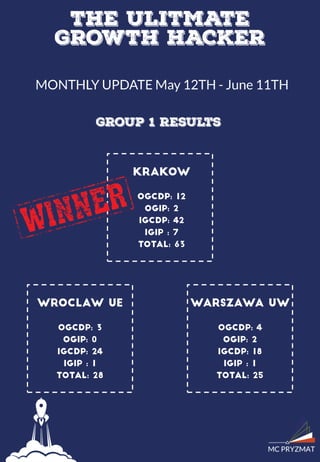
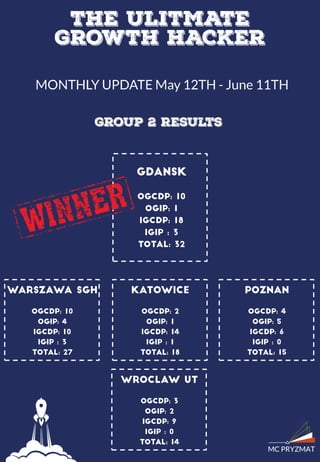
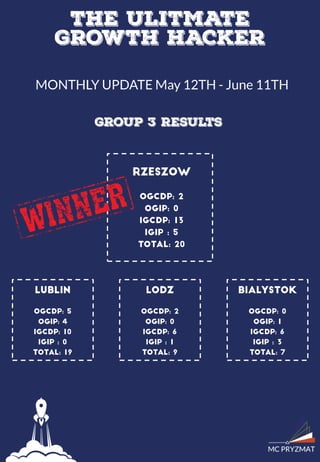
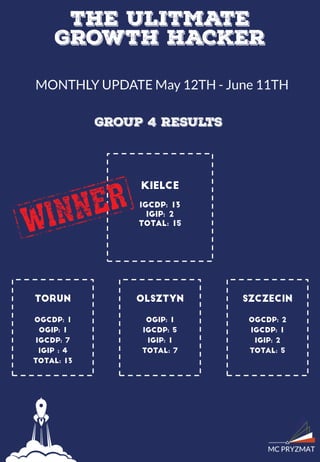
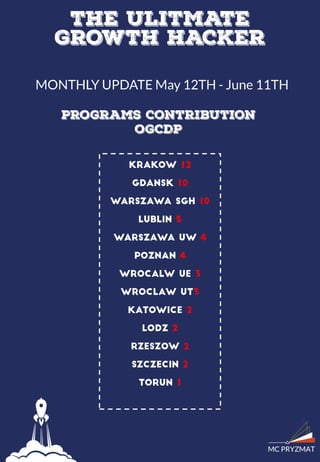

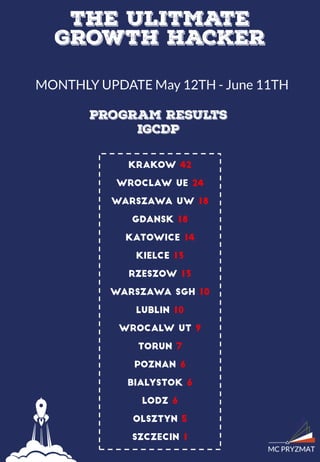

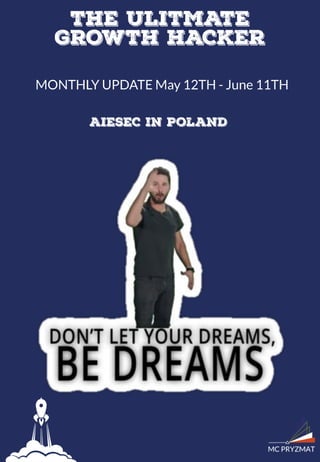
Recommended
AIESEC Poland Exchange Booklet
AIESEC Poland Exchange BookletAIESECPoland
Ěý
In OG GCDP, there are at least 3 recruitment opportunities available in each of their 18 committees. They are seeking excellent interns from various countries through a selection process. Most candidates from Poland are students interested in short-term internships between 6-12 weeks in fields like education, psychology, business, and project management. Recruitment peaks for these internships occur between March to May and October to November as well as between May to July and December to January.FairVote.org - Why NPV makes sense (for Utah)
FairVote.org - Why NPV makes sense (for Utah)kkellyfv
Ěý
The document summarizes that Ohio received disproportionate attention from presidential candidates in 2008 compared to smaller states, despite Ohio only making up around 3% of the total US population. It argues that the current Electoral College system marginalizes almost all states except a few battleground states that receive the vast majority of campaign visits and money. While defenders claim battleground states will change over time, some states like Utah and Rhode Island have not been battlegrounds in nearly a century, so the attention does not evenly shift over time as claimed. The document proposes a national popular vote as an alternative that would make every vote equally relevant and not ignore smaller states.Global citizen booklet aiesec in vietnam
Global citizen booklet aiesec in vietnamSophia Fan
Ěý
The document provides information about AIESEC Vietnam's Global Citizen Programme, which offers opportunities for young people to work on social projects abroad for 6-8 weeks. Some key details:
- AIESEC has a network of 113 countries and offers over 20,000 international experiences annually centered around social issues like education, environment, and poverty.
- The Global Citizen Programme provides cultural, social, and entrepreneurial exposure during participants' formative years through project work addressing issues like literacy, cultural understanding, and career development.
- Vietnamese students have participated in the program since 2005, with many going to Southeast Asia or Central Eastern Europe for their projects lasting 6-8 weeks. Selection involves an application and interview process.AIESEC in Poland MC 16/17 Second Round Application Booklet
AIESEC in Poland MC 16/17 Second Round Application Bookletaiesec_poland
Ěý
The document provides information about applying to be on the Member Committee (MC) for AIESEC in Poland for the 2016-2017 term. It includes details about the roles and responsibilities of the MC, application requirements and process, sample interview questions, and timelines. Some key points:
- The MC is responsible for leading the strategic direction of AIESEC in Poland and ensuring goals are met. Members live together and receive a monthly salary.
- To apply, candidates must submit a CV, endorsement letters, and answer up to 13 pages of questions covering their experience, strengths, and visions for various functional areas.
- Sample general questions ask about strengths, weaknesses, and visions for the MC's role andAIESEC Thailand NST Application Booklet
AIESEC Thailand NST Application BookletKate Crow
Ěý
This document provides information about open positions on the National Support Team (NST) in AIESEC Thailand for the 2015-2016 term. It describes several open roles on the NST across various functions, including International Relations Manager for GCDP, Finance Manager, Brand Manager, and Member Development Coordinator. For each role, it provides the required skills, time commitment expected, key responsibilities, and measures of success. The document instructs applicants to read the application booklet, look at the job descriptions, ask any clarifying questions, and submit an application by June 29th for interviews to be held from July 1st to 3rd. Successful candidates will be announced on July 6th.The Ultimate Growth Hacker summer 2016 - Monthly Update 1
The Ultimate Growth Hacker summer 2016 - Monthly Update 1aiesec_poland
Ěý
Summer 2016 R&R monthly update for @PLAD! MC 1617 booklet fourth round
MC 1617 booklet fourth roundaiesec_poland
Ěý
This document provides information about applying to be on the Member Committee (MC) team for AIESEC in Poland for the 2016-2017 term. It includes the following key points:
- The deadline to apply is May 11th at 8 PM GMT+2 by submitting an application package via email.
- The application package should include a CV, 2 endorsement letters, and a questionnaire not exceeding 11 pages.
- Interviews will take place after the deadline and the announcement of selections will be communicated later.
- The transition timeline requires the new MC team to move into the shared house by specific dates in May and June to complete the transition before the new term starts on July 1st.
-AIESEC in Poland MC 16/17 Third Round Application Booklet
AIESEC in Poland MC 16/17 Third Round Application Bookletaiesec_poland
Ěý
The document outlines the application process for the AIESEC in Poland Member Committee for the term 2016-2017, detailing roles, working conditions, requirements, and the selection timeline. It emphasizes the transformative experience and challenges involved in participating in the committee, along with a clear structure for candidates to submit their applications, including CVs and endorsement letters. Additionally, it highlights the responsibilities and expectations for prospective members in contributing to the organization's goals and operations.Sona intro + why
Sona intro + whyaiesec_poland
Ěý
State of National Affairs (SONA) is a process used by organizations to collect, analyze, and present crucial information about their functioning and performance. It involves gathering the most relevant data, thoroughly analyzing it, and communicating clear takeaways, recommendations, trends, and key messages to all stakeholders. SONA provides a review of implementation status, allows organizations to understand differences between goals and reality, and helps adjust strategy. It is considered necessary for tracking individual and team performance, driving the right operational culture, and setting action plans for the future.Internal ceed
Internal ceedaiesec_poland
Ěý
This document discusses an internal CEEDERSHIP program in AIESEC Poland to spread knowledge of their Global Talent Placement (GTP) program between local committees. Local committees will send representatives to other committees to learn about their operations and then implement the knowledge in their home committees. The timeline outlines the education, delivery, and implementation plans for representatives participating between April 11-17, 2016. Contact information is provided for the National Sales Coordinator and other leads for the program.iGIP+Carrer Days follow up Spring 2016
iGIP+Carrer Days follow up Spring 2016aiesec_poland
Ěý
The document provides guidance and initiatives for following up on Career Days to boost cooperation between Business Development and iGIP teams and increase iGIP sales. It outlines steps to take before, during, and after Career Days, including updating on companies, planning attendance, checking contact history, not directly selling but approaching interested companies, participating in evaluations, using the national clik tool, and contacting the listed coordinators with any questions. The final deadline for Career Days follow up is April 30th.IGIP General Rules 2016
IGIP General Rules 2016aiesec_poland
Ěý
Kasia requests changing the status of an Opportunity form from DRAFT to OPEN. The request includes the number of openings and confirms that the search tool has been updated. Good luck is wished for the task.Content Creation
Content Creationaiesec_poland
Ěý
The document announces a Hubspot workshop on content creation to be held on January 18th and hosted by Chuck Chaoke. It discusses how content is essential for inbound marketing and how creating the right content for target customers can attract prospects and keep them engaged. The document also provides examples of what constitutes content and presents a brand model outlining various benefits, personality traits, and positioning that can be communicated through content.oGCDP understanding
oGCDP understandingaiesec_poland
Ěý
This document provides an overview of AIESEC's Global Citizen program, including its history, present structure, and a SWOT analysis. The key points are:
1) AIESEC's Global Citizen program offers 6-8 week internships, study tours, and information exchanges in diverse cultures to help participants develop skills like cultural awareness, leadership, and social responsibility.
2) The program has evolved significantly since 1948 in terms of its matching platforms and operations.
3) A SWOT analysis identifies strengths like cost efficiency and diversity, weaknesses like low conversion rates, and opportunities to engage returnees, improve promotions, and develop new partnerships.Customer Flow Understanding
Customer Flow Understandingaiesec_poland
Ěý
- Clear understanding, efficient flow and customer centricity are objectives. The stages are attraction, consideration, value delivery, and brand advocacy.
- Main bottlenecks identified are slow response times during the matching process, lack of logistical information provided, and inconsistent experiences between opportunities described and realities.
- Customers noted positives like helpful hosting entities and opportunities for personal growth. Negatives included unclear processes, late or lack of preparation, insufficient support and communication, and projects not meeting expectations.
- To improve the flow, representatives should gather more customer feedback, standardize information and support provided, speed up matching and communication, and ensure opportunities are accurately portrayed and satisfying. Focusing more on customers needs at each stageLcp role (elects)
Lcp role (elects)aiesec_poland
Ěý
The document outlines the key responsibilities of a Local Committee President (LCP) in AIESEC. As the ultimate leadership role, an LCP acts as the guardian of the local committee's brand, guiding its values, behavior, and identity. An LCP is responsible for setting the local committee's direction and ensuring national and global alignment. As the team leader, an LCP drives team management, accountability, and the development of each team member. Externally, the LCP serves as the public face and official voice of the local committee. Strategically, an LCP creates the local vision while also understanding operations in detail to lead effectively.Mc role
Mc roleaiesec_poland
Ěý
The member committee (MC) serves as the servicing body for AIESEC in Poland. As a servicing body, the MC provides assistance, consultation, direction, and support to local committees. It serves to align AIESEC in Poland with international strategies and represents the organization externally. The MC also manages operations, legal and finance functions, conferences, and local committee development to help unify and strengthen the organization in Poland. It works to provide services like these through capable and experienced teams. The goal of the MC's work is to empower local committees and advance AIESEC's mission on a national level in Poland.Re looking the way we plan Sumco 2015 session
Re looking the way we plan Sumco 2015 sessionaiesec_poland
Ěý
The document discusses replanning for the next six months after reviewing performance over the past six months. It emphasizes analyzing what didn't work previously and using lessons learned to identify strategic changes to original plans. Replanning is not about reducing goals or using past strategies, but envisioning the next period while addressing current gaps to still achieve goals. An effective replanning package includes team priorities, gap analyses, operational projects, timelines, and growth drivers. Respective VPs and their teams develop replanning which the executive board finalizes with coach input and monitoring of implementation.Process flow re-planning 2015
Process flow re-planning 2015aiesec_poland
Ěý
This document provides guidance on the replanning process for leadership councils (LCs) over the next six months. The replanning process involves:
1. Analyzing performance over the past six months and identifying gaps.
2. Reflecting on successes and failures with the executive board (EB) and defining team and LC stands.
3. Revisiting area-based projects (ABPs) and exchange targets, identifying gaps, and determining new strategies and goals.
4. Developing an implementation plan through a Gantt chart to coordinate activities across areas over the next six months.
The overall process is meant to help LCs learn from the past, strategize for the future,Planning process session Nat-co 2016
Planning process session Nat-co 2016aiesec_poland
Ěý
The document discusses improving the ideal state and customer experience within an organization. It emphasizes keeping core customers at the center, using area strengths to enhance the customer experience, and different roles working together towards shared goals. It advises being physically and mentally present, sharing opinions, and not worrying too much about time as there is still some left to finalize plans while having fun with colleagues.NPM growth model
NPM growth modelaiesec_poland
Ěý
The growth model provides an overall direction and framework for major growth strategies to widen the organization's perspective and encourage long-term thinking. It identifies the most critical variables and plans according to a unified direction to bring stability and guidance while enabling strategic continuity. Having a growth model points out internal synergy opportunities and leads to healthy organizational growth throughout different contexts by considering how each element contributes to the overall path.MC buddies 2016
MC buddies 2016aiesec_poland
Ěý
This document discusses the MC buddy system in AIESEC, which aims to facilitate communication between local committees (LCs) and the management committee (MC). Key points:
1. Each LC has an MC buddy who is responsible for understanding the LC's situation and providing support. This helps the MC better develop strategies and the LC gain perspective.
2. The goal is for buddies to support each other through clear communication and understanding realities on the ground.
3. The system provides LCs access to MC experience and helps the MC understand implementation, while buddies also support each other personally.National Talent Plan Aug-Sept 2015
National Talent Plan Aug-Sept 2015aiesec_poland
Ěý
The document outlines the national talent plan for an organization between August-September 2015 and January 2016. It summarizes:
- They planned 737 exchanges in total for that period, with 67% (520 exchanges) focused on the iGCDP program area.
- Their recruitment goals included 180 trainees, 156 trainees/managers, and 780 managers across local committees.
- The majority of human resources would be allocated to the iGCDP program area, with 380 members, followed by other areas like Employer Branding with 178 members.
- The most needed job descriptions were sales & marketing with 268 and 172 members needed respectively.TMP Sept-Oct 2015
TMP Sept-Oct 2015aiesec_poland
Ěý
This document summarizes the results of the autumn 2015 recruitment process for AIESEC in Poland. It provides statistics on the number of applications received, members allocated, and the breakdown of men and women recruited. It also describes how different local committees conducted the recruitment process, including how many people were engaged, the training and preparation provided to assessors, and how allocation decisions were made. The summary highlights that they achieved 94.31% of their recruitment plans and allocated 778 new members total.TMP March 2015
TMP March 2015aiesec_poland
Ěý
The document provides results and analysis from AIESEC in Poland's March 2015 Future Leaders recruitment campaign. It summarizes that they recruited 889 new members, exceeding their 98.5% recruitment goal. Most applicants heard about the opportunity from friends in AIESEC or other online channels like Facebook. Analysis of the results shows which channels and profiles were most effective at recruiting and converting applicants. It also examines differences in performance across local committees. The report aims to identify best practices and areas for improvement for future recruitment campaigns.TMP Oct 2014
TMP Oct 2014aiesec_poland
Ěý
The document summarizes the results of AIESEC in Poland's October 2014 Future Leaders recruitment campaign. It reports that they received 1826 applications and allocated 783 new members and 31 returnees. Most applications and allocations were for the Social Entrepreneurship program. It provides details on the promotion campaign results such as the number of applications received by each local committee and the channels used. It also analyzes the recruitment process outcomes including number of people resigning after each stage and gender allocation results. Challenges in creating the report due to incomplete or inconsistent data from some local committees are also noted.TMP May/June 2014
TMP May/June 2014aiesec_poland
Ěý
The document provides an implementation report on the Future Leaders campaign run by 14 local committees of AIESEC in Poland from May-June 2014. Some key points:
- The campaign achieved 60% of its overall recruitment plans, recruiting 121 new members total.
- Engagement and promotion methods varied between committees, with the most effective being personal referrals from friends.
- Committees faced challenges with data tracking and strategy, and not all fully understood the value proposition of Future Leaders.
- While results provide room for improvement, the report argues Future Leaders is an important tool for communicating AIESEC's mission of leadership development.TMP Oct 2013
TMP Oct 2013aiesec_poland
Ěý
The document summarizes the results of AIESEC in Poland's largest recruitment effort in 2013. It reports that 2,440 applications were received, exceeding the promotion plan by 127%. Most applications came from Facebook, referrals from AIESEC members, and personal referrals. 9 out of 20 local committees achieved over 100% of their promotion goals. In total, 936 new members were recruited, achieving 79% of the overall talent plan. The recruitment process engaged many current members and required significant time investment. [END SUMMARY]Steering Excellence in Turbulent Times: A Strategic Governance Toolkit
Steering Excellence in Turbulent Times: A Strategic Governance Toolkitexec7
Ěý
In today’s volatile, uncertain, complex, and ambiguous (VUCA) world, strategic governance is no longer optional. It's imperative.
This şÝşÝߣShare from TEXEM, UK equips executives, board members, and business leaders with a practical governance toolkit to navigate turbulence with resilience, clarity, and confidence.
Explore actionable insights on:
- Strengthening governance structures in crisis
- Enabling adaptive leadership in times of disruption
- Enhancing stakeholder trust and boardroom decision-making
- Developing strategic foresight and agile planning capabilities
- Building resilient organisations that thrive—not just survive
Whether you're a C-suite executive, policy leader, or aspiring changemaker, this guide offers tools to drive excellence, accountability, and strategic transformation in a fast-changing world.
Use this toolkit to lead with boldness, agility, and purpose—no matter the storm.
To register for TEXEM’s executive programme that builds boardroom excellence, visit: www.texem.co.uk/strategic-governance-and-leadership-steering-excellence-in-turbulent-timesMore Related Content
More from aiesec_poland (20)
Sona intro + why
Sona intro + whyaiesec_poland
Ěý
State of National Affairs (SONA) is a process used by organizations to collect, analyze, and present crucial information about their functioning and performance. It involves gathering the most relevant data, thoroughly analyzing it, and communicating clear takeaways, recommendations, trends, and key messages to all stakeholders. SONA provides a review of implementation status, allows organizations to understand differences between goals and reality, and helps adjust strategy. It is considered necessary for tracking individual and team performance, driving the right operational culture, and setting action plans for the future.Internal ceed
Internal ceedaiesec_poland
Ěý
This document discusses an internal CEEDERSHIP program in AIESEC Poland to spread knowledge of their Global Talent Placement (GTP) program between local committees. Local committees will send representatives to other committees to learn about their operations and then implement the knowledge in their home committees. The timeline outlines the education, delivery, and implementation plans for representatives participating between April 11-17, 2016. Contact information is provided for the National Sales Coordinator and other leads for the program.iGIP+Carrer Days follow up Spring 2016
iGIP+Carrer Days follow up Spring 2016aiesec_poland
Ěý
The document provides guidance and initiatives for following up on Career Days to boost cooperation between Business Development and iGIP teams and increase iGIP sales. It outlines steps to take before, during, and after Career Days, including updating on companies, planning attendance, checking contact history, not directly selling but approaching interested companies, participating in evaluations, using the national clik tool, and contacting the listed coordinators with any questions. The final deadline for Career Days follow up is April 30th.IGIP General Rules 2016
IGIP General Rules 2016aiesec_poland
Ěý
Kasia requests changing the status of an Opportunity form from DRAFT to OPEN. The request includes the number of openings and confirms that the search tool has been updated. Good luck is wished for the task.Content Creation
Content Creationaiesec_poland
Ěý
The document announces a Hubspot workshop on content creation to be held on January 18th and hosted by Chuck Chaoke. It discusses how content is essential for inbound marketing and how creating the right content for target customers can attract prospects and keep them engaged. The document also provides examples of what constitutes content and presents a brand model outlining various benefits, personality traits, and positioning that can be communicated through content.oGCDP understanding
oGCDP understandingaiesec_poland
Ěý
This document provides an overview of AIESEC's Global Citizen program, including its history, present structure, and a SWOT analysis. The key points are:
1) AIESEC's Global Citizen program offers 6-8 week internships, study tours, and information exchanges in diverse cultures to help participants develop skills like cultural awareness, leadership, and social responsibility.
2) The program has evolved significantly since 1948 in terms of its matching platforms and operations.
3) A SWOT analysis identifies strengths like cost efficiency and diversity, weaknesses like low conversion rates, and opportunities to engage returnees, improve promotions, and develop new partnerships.Customer Flow Understanding
Customer Flow Understandingaiesec_poland
Ěý
- Clear understanding, efficient flow and customer centricity are objectives. The stages are attraction, consideration, value delivery, and brand advocacy.
- Main bottlenecks identified are slow response times during the matching process, lack of logistical information provided, and inconsistent experiences between opportunities described and realities.
- Customers noted positives like helpful hosting entities and opportunities for personal growth. Negatives included unclear processes, late or lack of preparation, insufficient support and communication, and projects not meeting expectations.
- To improve the flow, representatives should gather more customer feedback, standardize information and support provided, speed up matching and communication, and ensure opportunities are accurately portrayed and satisfying. Focusing more on customers needs at each stageLcp role (elects)
Lcp role (elects)aiesec_poland
Ěý
The document outlines the key responsibilities of a Local Committee President (LCP) in AIESEC. As the ultimate leadership role, an LCP acts as the guardian of the local committee's brand, guiding its values, behavior, and identity. An LCP is responsible for setting the local committee's direction and ensuring national and global alignment. As the team leader, an LCP drives team management, accountability, and the development of each team member. Externally, the LCP serves as the public face and official voice of the local committee. Strategically, an LCP creates the local vision while also understanding operations in detail to lead effectively.Mc role
Mc roleaiesec_poland
Ěý
The member committee (MC) serves as the servicing body for AIESEC in Poland. As a servicing body, the MC provides assistance, consultation, direction, and support to local committees. It serves to align AIESEC in Poland with international strategies and represents the organization externally. The MC also manages operations, legal and finance functions, conferences, and local committee development to help unify and strengthen the organization in Poland. It works to provide services like these through capable and experienced teams. The goal of the MC's work is to empower local committees and advance AIESEC's mission on a national level in Poland.Re looking the way we plan Sumco 2015 session
Re looking the way we plan Sumco 2015 sessionaiesec_poland
Ěý
The document discusses replanning for the next six months after reviewing performance over the past six months. It emphasizes analyzing what didn't work previously and using lessons learned to identify strategic changes to original plans. Replanning is not about reducing goals or using past strategies, but envisioning the next period while addressing current gaps to still achieve goals. An effective replanning package includes team priorities, gap analyses, operational projects, timelines, and growth drivers. Respective VPs and their teams develop replanning which the executive board finalizes with coach input and monitoring of implementation.Process flow re-planning 2015
Process flow re-planning 2015aiesec_poland
Ěý
This document provides guidance on the replanning process for leadership councils (LCs) over the next six months. The replanning process involves:
1. Analyzing performance over the past six months and identifying gaps.
2. Reflecting on successes and failures with the executive board (EB) and defining team and LC stands.
3. Revisiting area-based projects (ABPs) and exchange targets, identifying gaps, and determining new strategies and goals.
4. Developing an implementation plan through a Gantt chart to coordinate activities across areas over the next six months.
The overall process is meant to help LCs learn from the past, strategize for the future,Planning process session Nat-co 2016
Planning process session Nat-co 2016aiesec_poland
Ěý
The document discusses improving the ideal state and customer experience within an organization. It emphasizes keeping core customers at the center, using area strengths to enhance the customer experience, and different roles working together towards shared goals. It advises being physically and mentally present, sharing opinions, and not worrying too much about time as there is still some left to finalize plans while having fun with colleagues.NPM growth model
NPM growth modelaiesec_poland
Ěý
The growth model provides an overall direction and framework for major growth strategies to widen the organization's perspective and encourage long-term thinking. It identifies the most critical variables and plans according to a unified direction to bring stability and guidance while enabling strategic continuity. Having a growth model points out internal synergy opportunities and leads to healthy organizational growth throughout different contexts by considering how each element contributes to the overall path.MC buddies 2016
MC buddies 2016aiesec_poland
Ěý
This document discusses the MC buddy system in AIESEC, which aims to facilitate communication between local committees (LCs) and the management committee (MC). Key points:
1. Each LC has an MC buddy who is responsible for understanding the LC's situation and providing support. This helps the MC better develop strategies and the LC gain perspective.
2. The goal is for buddies to support each other through clear communication and understanding realities on the ground.
3. The system provides LCs access to MC experience and helps the MC understand implementation, while buddies also support each other personally.National Talent Plan Aug-Sept 2015
National Talent Plan Aug-Sept 2015aiesec_poland
Ěý
The document outlines the national talent plan for an organization between August-September 2015 and January 2016. It summarizes:
- They planned 737 exchanges in total for that period, with 67% (520 exchanges) focused on the iGCDP program area.
- Their recruitment goals included 180 trainees, 156 trainees/managers, and 780 managers across local committees.
- The majority of human resources would be allocated to the iGCDP program area, with 380 members, followed by other areas like Employer Branding with 178 members.
- The most needed job descriptions were sales & marketing with 268 and 172 members needed respectively.TMP Sept-Oct 2015
TMP Sept-Oct 2015aiesec_poland
Ěý
This document summarizes the results of the autumn 2015 recruitment process for AIESEC in Poland. It provides statistics on the number of applications received, members allocated, and the breakdown of men and women recruited. It also describes how different local committees conducted the recruitment process, including how many people were engaged, the training and preparation provided to assessors, and how allocation decisions were made. The summary highlights that they achieved 94.31% of their recruitment plans and allocated 778 new members total.TMP March 2015
TMP March 2015aiesec_poland
Ěý
The document provides results and analysis from AIESEC in Poland's March 2015 Future Leaders recruitment campaign. It summarizes that they recruited 889 new members, exceeding their 98.5% recruitment goal. Most applicants heard about the opportunity from friends in AIESEC or other online channels like Facebook. Analysis of the results shows which channels and profiles were most effective at recruiting and converting applicants. It also examines differences in performance across local committees. The report aims to identify best practices and areas for improvement for future recruitment campaigns.TMP Oct 2014
TMP Oct 2014aiesec_poland
Ěý
The document summarizes the results of AIESEC in Poland's October 2014 Future Leaders recruitment campaign. It reports that they received 1826 applications and allocated 783 new members and 31 returnees. Most applications and allocations were for the Social Entrepreneurship program. It provides details on the promotion campaign results such as the number of applications received by each local committee and the channels used. It also analyzes the recruitment process outcomes including number of people resigning after each stage and gender allocation results. Challenges in creating the report due to incomplete or inconsistent data from some local committees are also noted.TMP May/June 2014
TMP May/June 2014aiesec_poland
Ěý
The document provides an implementation report on the Future Leaders campaign run by 14 local committees of AIESEC in Poland from May-June 2014. Some key points:
- The campaign achieved 60% of its overall recruitment plans, recruiting 121 new members total.
- Engagement and promotion methods varied between committees, with the most effective being personal referrals from friends.
- Committees faced challenges with data tracking and strategy, and not all fully understood the value proposition of Future Leaders.
- While results provide room for improvement, the report argues Future Leaders is an important tool for communicating AIESEC's mission of leadership development.TMP Oct 2013
TMP Oct 2013aiesec_poland
Ěý
The document summarizes the results of AIESEC in Poland's largest recruitment effort in 2013. It reports that 2,440 applications were received, exceeding the promotion plan by 127%. Most applications came from Facebook, referrals from AIESEC members, and personal referrals. 9 out of 20 local committees achieved over 100% of their promotion goals. In total, 936 new members were recruited, achieving 79% of the overall talent plan. The recruitment process engaged many current members and required significant time investment. [END SUMMARY]Recently uploaded (17)
Steering Excellence in Turbulent Times: A Strategic Governance Toolkit
Steering Excellence in Turbulent Times: A Strategic Governance Toolkitexec7
Ěý
In today’s volatile, uncertain, complex, and ambiguous (VUCA) world, strategic governance is no longer optional. It's imperative.
This şÝşÝߣShare from TEXEM, UK equips executives, board members, and business leaders with a practical governance toolkit to navigate turbulence with resilience, clarity, and confidence.
Explore actionable insights on:
- Strengthening governance structures in crisis
- Enabling adaptive leadership in times of disruption
- Enhancing stakeholder trust and boardroom decision-making
- Developing strategic foresight and agile planning capabilities
- Building resilient organisations that thrive—not just survive
Whether you're a C-suite executive, policy leader, or aspiring changemaker, this guide offers tools to drive excellence, accountability, and strategic transformation in a fast-changing world.
Use this toolkit to lead with boldness, agility, and purpose—no matter the storm.
To register for TEXEM’s executive programme that builds boardroom excellence, visit: www.texem.co.uk/strategic-governance-and-leadership-steering-excellence-in-turbulent-timesSpatzAI Micro-Conflict Resolution Toolkit - Fairer Teamwork Globally
SpatzAI Micro-Conflict Resolution Toolkit - Fairer Teamwork GloballyDesmond Sherlock
Ěý
Workplace conflicts don’t always start with blowups—they begin as tiny spats, snide remarks, or ignored frustrations. SpatzAI is a real-time chat app and team review platform that empowers employees to address micro-conflicts before they escalate.1 Samuel 15.1-3 7-13 22-23 Foolish Defiance GPBC 06.15.25.pdf
1 Samuel 15.1-3 7-13 22-23 Foolish Defiance GPBC 06.15.25.pdfLazarou Richard
Ěý
Bible Study lesson on 1 Samuel 15 based on the Gospel Project curriculm. Uniting Voices, Building Leaders_ Inside the ICC National Leadership Summit b...
Uniting Voices, Building Leaders_ Inside the ICC National Leadership Summit b...Jacob Baime ICC
Ěý
At the heart of the summit is a belief in the power of student-led change.
Through keynote sessions, hands-on workshops, and interactive panel discussions, participants engage directly with experienced policy, diplomacy, and advocacy professionals. These sessions don’t just inform—they challenge students to think critically, speak persuasively, and confidently lead. Whether navigating difficult conversations or organizing campus-wide initiatives, attendees leave with tools grounded in real-world strategy.
LEADERSHIP Management in Nursing. Useful for students and Professionals
LEADERSHIP Management in Nursing. Useful for students and ProfessionalsMeenakshiVyas6
Ěý
Short and concise presentation on Leadership Management.3 Fedral Enterprise Architecture Framework (Eid Mohammad Ibrahimi).pdf
3 Fedral Enterprise Architecture Framework (Eid Mohammad Ibrahimi).pdfEidMohammad6
Ěý
The FEAF is a unique & high level management framework.Human Centricity as a driver for workplace innovation - Peter Oeij & Frank Kr...
Human Centricity as a driver for workplace innovation - Peter Oeij & Frank Kr...Peter Oeij
Ěý
Presentation for the conference "Advancing Industry 5.0: Building skills, enhancing employee voice and driving workplace innovation", Leuven (Belgium) 16-16 June 2025, organised by EUWIN, Broadvoice, Bridges5.0 and SEISMECMateri Financial Awareness Accelerate (Helmi Wandara).pptx
Materi Financial Awareness Accelerate (Helmi Wandara).pptxDindaAyu424485
Ěý
How do you think about money 250614-PV Inspection Observations-CQS.pdf
250614-PV Inspection Observations-CQS.pdfObaid Ali / Roohi B. Obaid
Ěý
Training session series of pharmaceutical professionalsQUALITY MANAGEMENT MX 2 QUALITY MANAGEMENT SYSTEMS.pptx
QUALITY MANAGEMENT MX 2 QUALITY MANAGEMENT SYSTEMS.pptxcherryhonours
Ěý
QUALITY MANAGEMENT MX 2 QUALITY MANAGEMENT SYSTEMS.pptx